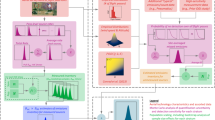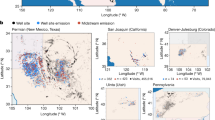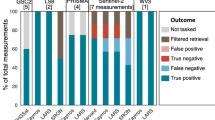Abstract
Methane is a powerful greenhouse gas and is targeted for emissions mitigation by the US state of California and other jurisdictions worldwide1,2. Unique opportunities for mitigation are presented by point-source emitters—surface features or infrastructure components that are typically less than 10 metres in diameter and emit plumes of highly concentrated methane3. However, data on point-source emissions are sparse and typically lack sufficient spatial and temporal resolution to guide their mitigation and to accurately assess their magnitude4. Here we survey more than 272,000 infrastructure elements in California using an airborne imaging spectrometer that can rapidly map methane plumes5,6,7. We conduct five campaigns over several months from 2016 to 2018, spanning the oil and gas, manure-management and waste-management sectors, resulting in the detection, geolocation and quantification of emissions from 564 strong methane point sources. Our remote sensing approach enables the rapid and repeated assessment of large areas at high spatial resolution for a poorly characterized population of methane emitters that often appear intermittently and stochastically. We estimate net methane point-source emissions in California to be 0.618 teragrams per year (95 per cent confidence interval 0.523–0.725), equivalent to 34–46 per cent of the state’s methane inventory8 for 2016. Methane ‘super-emitter’ activity occurs in every sector surveyed, with 10 per cent of point sources contributing roughly 60 per cent of point-source emissions—consistent with a study of the US Four Corners region that had a different sectoral mix9. The largest methane emitters in California are a subset of landfills, which exhibit persistent anomalous activity. Methane point-source emissions in California are dominated by landfills (41 per cent), followed by dairies (26 per cent) and the oil and gas sector (26 per cent). Our data have enabled the identification of the 0.2 per cent of California’s infrastructure that is responsible for these emissions. Sharing these data with collaborating infrastructure operators has led to the mitigation of anomalous methane-emission activity10.
This is a preview of subscription content, access via your institution
Access options
Access Nature and 54 other Nature Portfolio journals
Get Nature+, our best-value online-access subscription
$29.99 / 30 days
cancel any time
Subscribe to this journal
Receive 51 print issues and online access
$199.00 per year
only $3.90 per issue
Buy this article
- Purchase on Springer Link
- Instant access to full article PDF
Prices may be subject to local taxes which are calculated during checkout



Similar content being viewed by others
Data availability
Radiance and reflectance products calibrated by AVIRIS-NG can be ordered from the AVIRIS-NG data portal at https://avirisng.jpl.nasa.gov/alt_locator/. Retrieved methane images from flight lines in this study are available for download at https://doi.org/10.3334/ORNLDAAC/1727. Vista-CA infrastructure spatial layers are available for download at https://doi.org/10.3334/ORNLDAAC/1726. Images of methane plumes, Vista-CA layers and regional-scale methane-emission products for California can be viewed at https://methane.jpl.nasa.gov/. Tables of methane plume and source characteristics are provided in the Supplementary Information.
Code availability
The custom computer code or algorithms used to generate the results in this study can be made available to researchers upon request.
References
California Senate Bill 1383. Short-Lived Climate Pollutants https://legiscan.com/CA/bill/SB1383/2015 (2016).
Global Methane Initiative. https://www.globalmethane.org (2019).
Zavala-Araiza, D. et al. Super-emitters in natural gas infrastructure are caused by abnormal process condition. Nat. Commun. 8, 14012 (2017).
National Academies of Sciences, Engineering, and Medicine. Improving Characterization of Anthropogenic Methane Emissions in the United States (National Academies Press, 2018).
Hamlin, L. et al. Imaging spectrometer science measurements for terrestrial ecology: AVIRIS and new developments. In IEEE Aerospace Conf. Proc. https://ieeexplore.ieee.org/document/5747395 (2011).
Thorpe, A. K. et al. Airborne DOAS retrievals of methane, carbon dioxide, and water vapor concentrations at high spatial resolution: application to AVIRIS-NG. Remote Sens. Environ. 179, 104–115 (2016).
Thompson, D. R. et al. Real-time remote detection and measurement for airborne imaging spectroscopy: a case study with methane. Atmos. Meas. Tech. 8, 4383–4397 (2015).
California Greenhouse Gas Emission Inventory. Methane emissions for 2016. California Air Resources Board https://ww3.arb.ca.gov/cc/inventory/data/tables/ghg_inventory_by_ipcc_all_00-17.xlsx (2018).
Frankenberg, C. et al. Airborne methane remote measurements reveal heavy-tail flux distribution in Four Corners region. Proc. Natl Acad. Sci. USA 113, 9734–9739 (2016).
Photojournal. NASA instrument detects methane gas leak. Jet Propulsion Laboratory/California Institute of Technology https://photojournal.jpl.nasa.gov/catalog/PIA22467 (2018).
Wecht, K. J. et al. Spatially resolving methane emissions in California: constraints from the CalNex aircraft campaign and from present (GOSAT, TES) and future (TROPOMI, geostationary) satellite observations. Atmos. Chem. Phys. 14, 8173–8184 (2014).
Turner, A. J. et al. Estimating global and North American methane emissions with high spatial resolution using GOSAT satellite data. Atmos. Chem. Phys. 15, 7049–7069 (2015).
Jeong, S. et al. A multitower measurement network estimate of California’s methane emissions. J. Geophys. Res. Atmos. 118, 11339–11351 (2013).
Wong, C. K. et al. Monthly trends of methane emissions in Los Angeles from 2011 to 2015 inferred by CLARS-FTS observations. Atmos. Chem. Phys. 16, 13121–13130 (2016).
Jeong, S., Millstein, D. & Fischer, M. L. Spatially explicit methane emissions from petroleum production and the natural gas system in California. Environ. Sci. Technol. 48, 5982–5990 (2014).
Alvarez, R. et al. Reconciling divergent estimates of oil and gas methane emissions. Proc. Natl Acad. Sci. USA 112, 15597–15602 (2015).
Brandt, A. et al. Methane leaks from North American natural gas systems. Science 343, 733–735 (2014).
California Assembly Bill 1496. Methane emissions. https://legiscan.com/CA/bill/AB1496/2015 (2016).
Saunois, M. et al. The global methane budget 2000–2012. Earth Syst. Sci. Data 8, 697–751 (2016).
Jeong, S. et al. Estimating methane emissions from biological and fossil-fuel sources in the San Francisco Bay Area. Geophys. Res. Lett. 44, 486–495 (2016).
Verhulst, K. R. et al. Carbon dioxide and methane measurements from the Los Angeles Megacity Carbon Project. Part 1: calibration, urban enhancements, and uncertainty estimates. Atmos. Chem. Phys. 17, 8313–8341 (2017).
Yadav, V. et al. Spatio-temporally resolved methane fluxes from the Los Angeles Megacity. J. Geophys. Res. Atmos. 124, 5131–5148 (2019).
Conley, S. et al. Methane emissions from the 2015 Aliso Canyon blowout in Los Angeles, CA. Science 351, 1317–1320 (2016).
Krautwurst, S. et al. Methane emissions from a Californian landfill, determined from airborne remote sensing and in situ measurements. Atmos. Meas. Tech. 10, 3429–3452 (2017).
Mouroulis, P. & Green, R. O. Review of high fidelity imaging spectrometer design for remote sensing. Opt. Eng. 57, 040901 (2018).
Thompson, D. R. et al. Space-based remote imaging spectroscopy of the Aliso Canyon CH4 superemitter. Geophys. Res. Lett. 43, 6571–6578 (2016).
Englander, J. G., Brandt, A. R., Conley, S., Lyon, D. R. & Jackson, R. B. Aerial interyear comparison and quantification of methane emissions persistence in the Bakken Formation of North Dakota, USA. Environ. Sci. Technol. 52, 8947–8953 (2018).
Greenhouse Gas Reporting Program (GRP). United States Environmental Protection Agency https://www.epa.gov/ghgreporting/ghg-reporting-program-data-sets (2018).
Etminan, M., Myhre, G., Highwood, E. J. & Shine, K. P. Radiative forcing of carbon dioxide, methane, and nitrous oxide: a significant revision of the methane radiative forcing. Geophys. Res. Lett. 43, 12614–12623 (2016).
Jacob, D. J. et al. Satellite observations of atmospheric methane and their value for quantifying methane emissions. Atmos. Chem. Phys. 16, 14371–14396 (2016).
Methane Hotspots Research (AB1496). Airborne Facility-Level Methane Emissions Study California Air Resources Board https://ww2.arb.ca.gov/our-work/programs/methane/ab1496-research (2018).
Acknowledgements
We thank the AVIRIS-NG team and Dynamic Aviation for their efforts in conducting the multiple airborne campaigns involved in this study, and our former colleague at the Jet Propulsion Laboratory (JPL), A. Aubrey, for early support in project planning. We acknowledge G. Franco (California Energy Commission, CEC) and E. Tseng (University of California Los Angeles) for comments on the paper. We appreciate the many discussions and input to flight planning and analysis from our colleagues at the California Air Resources Board (CARB), the Bay Area Air Quality Management District, the South Coast Air Quality Management District, the CEC, Southern California Gas Company, Sunshine Canyon Landfill Local Enforcement Agency, and the Milk Producer’s Council. We thank our colleagues at the Pacific Gas and Electric Company for their support for natural gas control release tests. We thank NASA’s Earth Science Division, particularly J. Kaye, for continued support of AVIRIS-NG methane science. Additional funding for data collection and analysis was provided to JPL by CARB under ARB-NASA Agreement 15RD028 Space Act Agreement 82-19863 and the CEC under CEC-500-15-004. The data from follow-up and contemporaneous Scientific Aviation flights used in this study were funded by CARB. Analysis of this work was also supported in part by NASA’s Carbon Monitoring System (CMS) Prototype Methane Monitoring System for California and the Advancing Collaborative Connections for Earth System Science (ACCESS) Methane Source Finder project. A portion of this research was carried out at the JPL, California Institute of Technology, under contract with NASA (NNN12AA01C). The authors are responsible for the content of the paper and the findings do not represent the views of the funding agencies.
Author information
Authors and Affiliations
Contributions
R.M.D., A.K.T., F.M.H. and C.E.M conceived the study. R.M.D., A.K.T., F.M.H., T.R., I.B.M., M.L.E. and S.C. conducted flight planning. Each author contributed to the collection, analysis or assessment of one or more datasets necessary to perform this study. R.M.D., A.K.T., K.T.F., F.M.H. and T.R performed the analysis with contributions from B.D.B., D.R.T., C.F., N.K.C., M.F., J.D.H, B.E.C., R.O.G. and V.Y. R.M.D., A.K.T., K.T.F. and F.M.H. wrote the manuscript with input from all authors.
Corresponding author
Ethics declarations
Competing interests
The authors declare no competing interests.
Additional information
Publisher’s note Springer Nature remains neutral with regard to jurisdictional claims in published maps and institutional affiliations.
Supplementary information
Supplementary Information
Supplementary Information file includes Materials and Methods, Supplementary Figs 1–14, Supplementary Tables 1–3, descriptions of Supplementary Tables 4 and 5, and additional references.
Supplementary Table 4
Methane plume list.
Supplementary Table 5
Methane source list.
Rights and permissions
About this article
Cite this article
Duren, R.M., Thorpe, A.K., Foster, K.T. et al. California’s methane super-emitters. Nature 575, 180–184 (2019). https://doi.org/10.1038/s41586-019-1720-3
Received:
Accepted:
Published:
Issue Date:
DOI: https://doi.org/10.1038/s41586-019-1720-3
This article is cited by
-
Methane emissions from landfills differentially underestimated worldwide
Nature Sustainability (2024)
-
US oil and gas system emissions from nearly one million aerial site measurements
Nature (2024)
-
Decadal decrease in Los Angeles methane emissions is much smaller than bottom-up estimates
Nature Communications (2023)
-
Semantic segmentation of methane plumes with hyperspectral machine learning models
Scientific Reports (2023)
-
Global declines of offshore gas flaring inadequate to meet the 2030 goal
Nature Sustainability (2023)
Comments
By submitting a comment you agree to abide by our Terms and Community Guidelines. If you find something abusive or that does not comply with our terms or guidelines please flag it as inappropriate.



